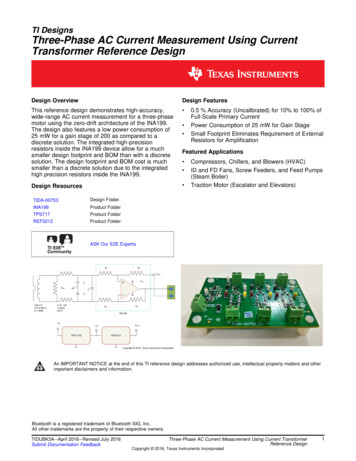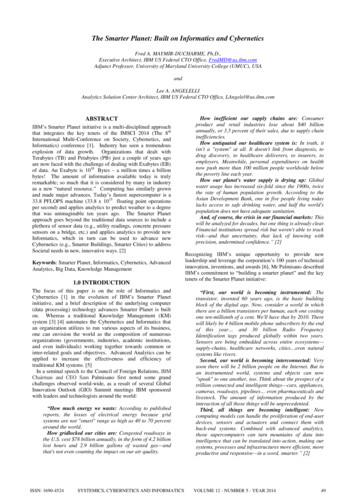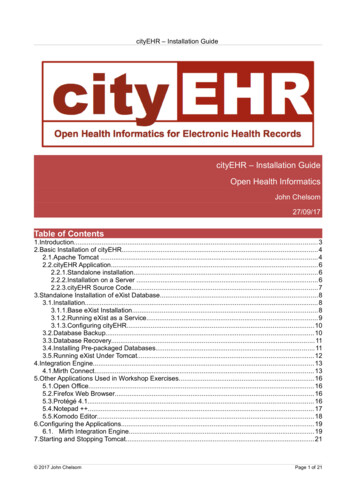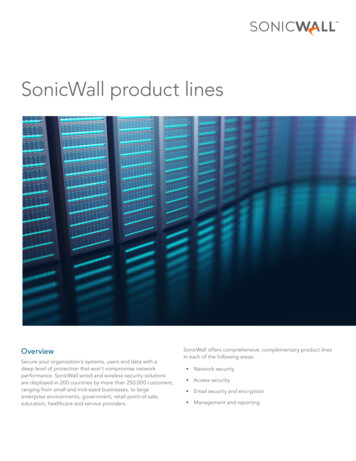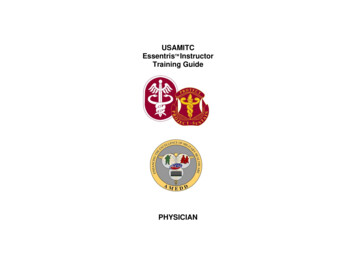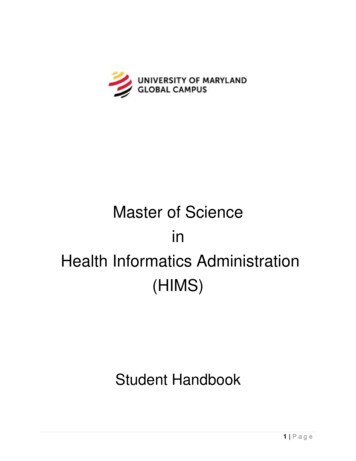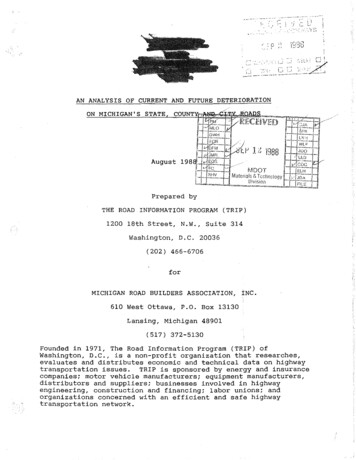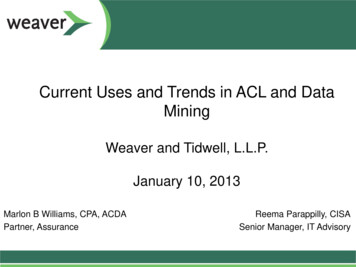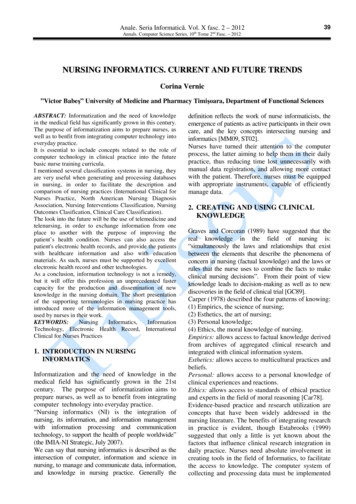
Transcription
Anale. Seria Informatică. Vol. X fasc. 2 – 201239Annals. Computer Science Series. 10th Tome 2nd Fasc. – 2012NURSING INFORMATICS. CURRENT AND FUTURE TRENDSCorina Vernic”Victor Babeş” University of Medicine and Pharmacy Timişoara, Department of Functional SciencesABSTRACT: Informatization and the need of knowledgein the medical field has significantly grown in this century.The purpose of informatization aims to prepare nurses, aswell as to benfit from integrating computer technology intoeveryday practice.It is essential to include concepts related to the role ofcomputer technology in clinical practice into the futurebasic nurse training curricula.I mentioned several classification systems in nursing, theyare very useful when generating and processing databasesin nursing, in order to facilitate the description andcomparison of nursing practices (International Clinical forNurses Practice, North American Nursing DiagnosisAssociation, Nursing Interventions Classification, NursingOutcomes Clasification, Clinical Care Classification).The look into the future will be the use of telemedicine andtelenursing, in order to exchange information from oneplace to another with the purpose of improving thepatient’s health condition. Nurses can also access thepatient's electronic health records, and provide the patientswith healthcare information and also with educationmaterials. As such, nurses must be supported by excellentelectronic health record and other technologies.As a conclusion, information technology is not a remedy,but it will offer this profession an unprecedented fastercapacity for the production and dissemination of newknowledge in the nursing domain. The short presentationof the supporting terminologies in nursing practice hasintroduced more of the information management tools,used by nurses in their logy, Electronic Health Record, InternationalClinical for Nurses Practices1. INTRODUCTION IN NURSINGINFORMATICSInformatization and the need of knowledge in themedical field has significantly grown in the 21stcentury. The purpose of informatization aims toprepare nurses, as well as to benefit from integratingcomputer technology into everyday practice.“Nursing informatics (NI) is the integration ofnursing, its information, and information managementwith information processing and communicationtechnology, to support the health of people worldwide”(the IMIA-NI Strategic, July 2007).We can say that nursing informatics is described as theintersection of computer, information and science innursing, to manage and communicate data, information,and knowledge in nursing practice. Generally thedefinition reflects the work of nurse informaticists, theemergence of patients as active participants in their owncare, and the key concepts intersecting nursing andinformatics [MM09, ST02].Nurses have turned their attention to the computerprocess, the latter aiming to help them in their dailypractice, thus reducing time lost unnecessarily withmanual data registration, and allowing more contactwith the patient. Therefore, nurses must be equippedwith appropriate instruments, capable of efficientlymanage data.2. CREATING AND USING CLINICALKNOWLEDGEGraves and Corcoran (1989) have suggested that thereal knowledge in the field of nursing is:“simultaneously the laws and relationships that existbetween the elements that describe the phenomena ofconcern in nursing (factual knowledge) and the laws orrules that the nurse uses to combine the facts to makeclinical nursing decisions”. From their point of viewknowledge leads to decision-making as well as to newdiscoveries in the field of clinical trial [GC89].Carper (1978) described the four patterns of knowing:(1) Empirics, the science of nursing;(2) Esthetics, the art of nursing;(3) Personal knowledge;(4) Ethics, the moral knowledge of nursing.Empirics: allows access to factual knowledge derivedfrom archives of aggregated clinical research andintegrated with clinical information system.Esthetics: allows access to multicultural practices andbeliefs.Personal: allows access to a personal knowledge ofclinical experiences and reactions.Ethics: allows access to standards of ethical practiceand experts in the field of moral reasoning [Car78].Evidence-based practice and research utilization areconcepts that have been widely addressed in thenursing literature. The benefits of integrating researchin practice is evident, though Estabrooks (1999)suggested that only a little is yet known about thefactors that influence clinical research integration indaily practice. Nurses need absolute involvement increating tools in the field of Informatics, to facilitatethe access to knowledge. The computer system ofcollecting and processing data must be implemented
40Anale. Seria Informatică. Vol. X fasc. 2 – 2012Annals. Computer Science Series. 10th Tome 2nd Fasc. – 2012on a wide scale, and the standards that concerndocumenting in the field of nursing must use thesolutions offered by information technology (IT),with the hope that they evolve [Est07].Strategies that will need implementation: identifying the nurse leader’s needs of educationin computer science; developing mentoring programs for theacquisition of leadership skills in computerscience; assuring enrollment of nurse leaders as sponsorsfor electronic health records initiatives.3. CLINICAL PRACTICEIn spite of efforts to implement a more efficient andeasier to use computerized system, there is stilllimited online functionality when it comes to thepossibility of nurse information. Many studies andreports have shown that many are still in the earlyphase of purchasing and implementing a computersystem [EP06].There is one opportunity of involving nurses in thedevelopment of the information system and in gettingIT solutions in terms of clinical practice. Consideringthe average age of the majority of nurses, it isunderstood that getting familiar with the use ofcomputers is necessary, so attention should be givento their private documentation in the field of IT.Strategies for Nurses: nurses must be encouraged to participate in theacquisition,design,implementationandevaluation phases of the information system; IT solutions must be adopted to help benefit aquality clinical care; nurses must be supplied with materials andresources that will facilitate the acquisition ofcompetence in the field of informatics.4. NURSES OF EDUCATIONOver the years, numerous efforts have been made toidentify the essence of competences the nurses wouldrequire for a good functionality of the medical system.The essence of concepts and competencies in theinformatics field is in a more private way related toan interprofessional education model.Staggers, Gassert and Curran believe that nursingstudents and nurses in general should be taught skillsin NI [SGC01].Staggers, Gassert and Curran (2001) specify that thenurses should be able to see relationships among dataelements, make judgments based on trends andpatterns within the data, use current informaticssolutions, and also collaborate with the informaticsnurse specialists. It is emphasized that the nursesmust be able to use system applications to managedata, information, and knowledge in differentspecialties, as well as promote the integrity andaccess to information related to confidentiality,legality, ethical, and security issues [SGC01].There's an assumption that those who will nowgraduate will be more familiar with the computersystem compared to nurses who already practice. Itis essential to include concepts related to the role ofcomputer technology in clinical practice into thefuture basic nurse training curricula.Education strategies in nursing informatics: the need to promote prototypes of informaticsintegration in schools of nursing; create opportunities to educate and spreadcompetencies and information concepts; nursing faculties compulsory need to obtain corecompetencies in the IT field; allocation of funds for the development of amodel of innovative curricula; include criteria for accreditation that requireintegrating basic informatics concepts andcompetencies in all basic nursing programs.As a representative of Romania for NursingInformatics in International Medical InformaticsAssociation and European Federation for MedicalInformatics, I designed the following AnalyticalProgram for Medical Informatics and BiostatisticsDepartment for General Medical Assistance in ourUniversity: Table 1and Table 2.Table 1.Course topicsNo.1.2.3.4.5.6.7.8.9.10.11.12.13.14.Course topicsIntroduction to information theory. Theobjects of study in Medical InformaticsComputing system. Hardware. Software.Operating systems. Integrated softwareComputer Networks. InternetTelemedicine. TelenursingData files. Medical databases.Classification systems: ICD-10, ATC, ICNP,NANDA, CCC of Nursing Diagnoses.Reports on DRG, SIUI.Electronic Health RecordIntroduction in Biostatistics. Statisticalparameters. DistributionStatistical tests. Classification of tests. Usualstatistical tests. Correlation analysisRisk analysis. Health statistics.Image processing. Image acquisition.Medical informatics systemsComputer systems used in clinics andhospitalsProtection and data security. Health Card.Electronic prescription.Practical works topics are presented in Table 2.
Anale. Seria Informatică. Vol. X fasc. 2 – 201241Annals. Computer Science Series. 10th Tome 2nd Fasc. – 2012Table 2. Practical worksNo.1.2.3.4.5.6.7.8.9.10.11.12.13.14.Practical works topicsIntroduction in Windows. Utility programsWord for Windows. TypesettingWord for Windows. ExercisesInternet surfingInternet surfing – specific to nursing activityMicrosoft Power PointPower Point PresentationSingle patient medical chart – ICMED(Figure 1)Databases. Introduction in EPI InfoSpreadsheets. Introduction in ExcelStatistical and Epidemiological problems.EPI Info and Excel (Figure 2).Image processing. Image J (Figure 3)Integrated system for family doctors –MedinsStatistics SeminarMasters also have an important role in preparingnurses. There is an international Master’s Course inHealth Informatics for Nurses: Introduction in HealthInformatics; Introduction in Health Sciencies;Hospital information systems – NIS; Databases;Research methodology; Security of HealthInformation; Electronic Patient Record; Telemedicine. etc. International doctoral programs exist forgetting PhD for nurses.Figure 2. Analysis menu in EPI InfoFigure 3. Image J main menu5. CLASSIFICATION SYSTEMS IN NURSINGFigure 1. ICMed main menuI will mention some of the most used classificationsystems [SM06].International Clinical for Nurses Practice (ICNP) isan international classification used in nurse practicewhich was created and developed by the InternationalCouncil of Nurses in Geneva, Switzerland. ICNP is astandardized terminology, a classification with amulti-axial structure used to represent diagnoses,interventions and outcomes in health care. Benefits ofICNP: It establishes an international standard, inorder to facilitate the description and comparison ofnursing practices; It serves as a unifying unitarysystem of nursing languages in international practice;It represents concepts used in local, regional, nationaland international medical assistance, in differentspecialties, languages and cultures; It generatesinformation about thenurse practice, which will
42Anale. Seria Informatică. Vol. X fasc. 2 – 2012Annals. Computer Science Series. 10th Tome 2nd Fasc. – 2012influence educational and decision-making processes,patient care related policies, medical assistanceInterventions, as well as the use of resources; Itfacilitates getting healthcare data, through thedescription and the comparison of medical care toindividuals, families and communities worldwide; Itimproves communication within the discipline ofnursing as well as other disciplines; It encouragesnurses to reflect on their practices and improve themedical care quality.North American Nursing Diagnosis Association(NANDA) is a guide about the classification ofnursing diagnoses in a taxonomy and it includesdefinitions and defining characteristics.Benefits of the NANDA classification system: Itprovides a standardized language to nurses for theirpractice description that can be used to communicatewith nurses of all specialties, members of other healthcare disciplines; It provides a classifier as well as asystem for the development, validation andclassification of nursing terminologies.Nursing Interventions Classification (NIC) contains514 nursing intervention that describe the treatmentnurses perform, updated linkages with NANDAdiagnoses.Nursing Outcomes Clasification (NOC) has 330results based on research to provide standardizationof expected patient, caregiver, family and communityresults for measuring the effect of healthcareinterventions. Each result features a definition, a setof specific indicators, measures to facilitateimplementation and clinical reference.Clinical Care Classification (CCC) is a research-basednomenclature designed to standardize the terminologiesfor documenting nursing care in all clinical caresettings. Exists: CCC Nursing Diagnosis and Outcomesand CCC Nursing Interventions and Actions.The CCC System is being used to document nursingcare in the electronic health record (EHR) computerbased patient record and Personal Health RecordSystem.The CCC System is used to: document integratedpatient care process; classify and track clinical care;develop evidence-based practice model; analyzepatient profiles and populations; predict care needs,resources, and costs [SM06].6. NURSING RESEARCHThe Foundation of Knowledge model suggests thatthe most important aspect of discovering informationis the ability to purchase, process, generate anddisseminate knowledge that had been acquired. Asinformation in the field of nursing site combines awide range of issues pertaining to clinical practice,research, administration and education, this paradigmwill catapult nurses in fro
Education strategies in nursing informatics: the need to promote prototypes of informatics integration in schools of nursing; create opportunities to educate and spread competencies and information concepts; nursing faculties compulsory need to obtain core competencies in the IT field;
